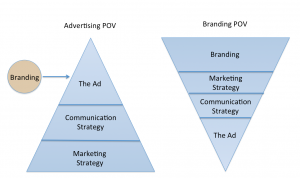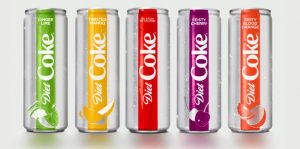“Let’s just get the ad concept right, then we’ll add the branding to it.”
“We’ll write the tag lines after the ad concepts are done.”
“Branding is more of a collective, long-term goal; advertising is for the here and now.”
 These are verbatim quotes from ad agencies with which I am consulting right now. Each time I paused to wonder why they brought me on in the first place as a seasoned advisor. I used to take it personally: Why buy a thoroughbred only to walk it around the track? Lately I realize that it is a fundamental breakdown on the part of ad agency personnel: either they refuse to admit that their job function as ad people is subordinate to the brand identity, or they are intellectually unwilling or incapable of distinguishing branding from advertising. Either way, the brands on which they are working deserve better.
These are verbatim quotes from ad agencies with which I am consulting right now. Each time I paused to wonder why they brought me on in the first place as a seasoned advisor. I used to take it personally: Why buy a thoroughbred only to walk it around the track? Lately I realize that it is a fundamental breakdown on the part of ad agency personnel: either they refuse to admit that their job function as ad people is subordinate to the brand identity, or they are intellectually unwilling or incapable of distinguishing branding from advertising. Either way, the brands on which they are working deserve better.
I should note that we are talking about healthcare ad agency personnel at the moment—those who work in an industry where branding is barely recognized let alone lionized. The overwhelming majority of healthcare ad agencies do not even have branding strategists or graphic design experts on staff. When it’s time to execute the branding strategy, they build the advertising concepts and then whichever idea is central to the “winning” concept becomes—by default—the strategy.  When it’s time to do the “branding” (e.g. the logo), they dole out the task to whichever art director happens to be on the job. Those not in the healthcare communications industry may think I’m being snarky here. But up until very recently, not a single industry awards show even had a branding category (Graphic Design USA broke the mold in their October 2017 issue and my branding firm won six awards). So no awards for healthcare branding = no ad agency creative director gets interested in the topic.
When it’s time to do the “branding” (e.g. the logo), they dole out the task to whichever art director happens to be on the job. Those not in the healthcare communications industry may think I’m being snarky here. But up until very recently, not a single industry awards show even had a branding category (Graphic Design USA broke the mold in their October 2017 issue and my branding firm won six awards). So no awards for healthcare branding = no ad agency creative director gets interested in the topic.
But the problem is no less serious in many of the consumer brands out on the market as well. As mega ad agencies gain leverage inside consumer goods companies, the tail begins to wag the dog. Witness the most recent decision by Coca-Cola to literally dilute the brand equity of Diet Coke by bringing out flavored line extensions of one of their flagship identities: Twisted Mango? Feisty Cherry? Zesty Blood Orange? What on Earth are the brand loyalists of the second most popular soda to think? According to the company, the move is calculated to counter the slumping sales of the beverage, especially as millennials take center stage.  Advertising says, “hey, let’s send a message that fizzy soft drinks can be more “naturally good” than that old cola stuff.” Branding asks, “hey, will people drink Diet Coke if they believe it’s healthier?” It’s no secret that consuming vast quantities of the beverage are not very good for you. But Diet Coke customers don’t really care. They like the way it refreshes and energizes (thanks caffeine). My wife—a fierce brand loyalist—sums it up thusly: “If God himself were to come down and tell me not to drink it for my health’s sake, I’d say ‘I’m good.’” The declining sales of soft drinks due to millennials’ preference for pro-health products is not a problem that can be solved by dressing up an existing bad-health brand with a health image. It’s a shift that’s best addressed by establishing new brands that address customers’ changing perceptions. Coca-Cola should have just created another line of branded “healthy” drinks and left their sacred franchise alone. We’ve seen this movie before.
Advertising says, “hey, let’s send a message that fizzy soft drinks can be more “naturally good” than that old cola stuff.” Branding asks, “hey, will people drink Diet Coke if they believe it’s healthier?” It’s no secret that consuming vast quantities of the beverage are not very good for you. But Diet Coke customers don’t really care. They like the way it refreshes and energizes (thanks caffeine). My wife—a fierce brand loyalist—sums it up thusly: “If God himself were to come down and tell me not to drink it for my health’s sake, I’d say ‘I’m good.’” The declining sales of soft drinks due to millennials’ preference for pro-health products is not a problem that can be solved by dressing up an existing bad-health brand with a health image. It’s a shift that’s best addressed by establishing new brands that address customers’ changing perceptions. Coca-Cola should have just created another line of branded “healthy” drinks and left their sacred franchise alone. We’ve seen this movie before.
Remember the Taco Bell Chihuahua back in the 90s? The talking dog that used to verbally beg people for Chalupas and such? Cute advertising concept. Awareness of the ad campaign was through the roof. But Taco Bell sales flattened and declined. Why? Because ad agencies try to solve branding problems with advertising. Taco Bell’s brand is about a fun alternative to McDonalds and Burger King.  What does a talking Chihuahua have to do with the brand identity? Nothing good. Branding research done by the chain revealed that the ads made customers think of Taco Bell as dog food. A smart branding solution found its way to reasserting the identity with the well-branded tag line, Think Outside The Bun. However, this was an expensive lesson.
What does a talking Chihuahua have to do with the brand identity? Nothing good. Branding research done by the chain revealed that the ads made customers think of Taco Bell as dog food. A smart branding solution found its way to reasserting the identity with the well-branded tag line, Think Outside The Bun. However, this was an expensive lesson.
And this is the sad truth about advertising as one of the worst enemies of branding: a lot more money is spent on advertising than on branding, and since money is the measure of greatness in a capitalistic society, advertising campaigns exert a power in the communications mix that’s like a runaway train. Just because it’s more expensive, it must be the best thing to do, right?
So let’s not finish the ad concept and then add the branding after. Ads should use branding as the fuel for their fire, not the parsley on their plate. And ads are NOT the “here and now” but rather one small step on a brand’s pathway to greatness—a greatness that is borne of integrity and consistency in fielding the brand experience. The next time your ad agency presents you with a campaign concept, ask them how it advances your brand’s identity—how does it endear your customers to the brand values they esteem most in your product or service? If they don’t have a good answer—or ANY answer at all—fire them and hire a branding thoroughbred and let him race to a winning finish for you.
